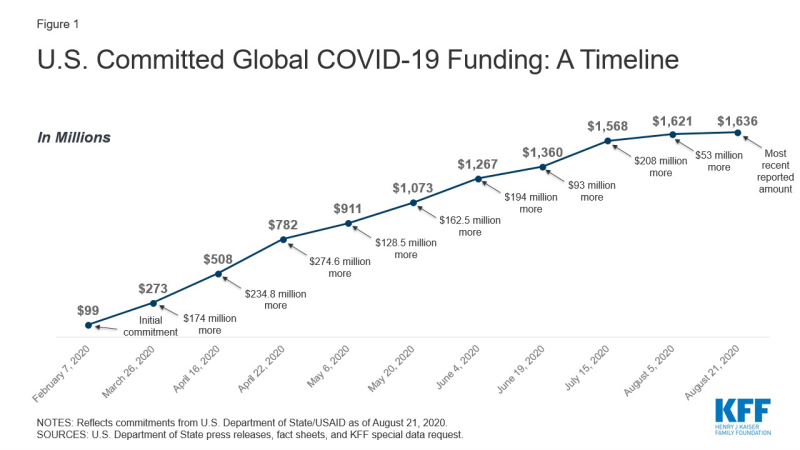U.S. Global Funding for COVID-19 by Country and Region
As of October 16, Congress has enacted four emergency supplemental funding bills to address the COVID-19 pandemic, which collectively provide almost $3.2 billion for the global response. Of this amount, approximately $2.4 billion (75%) was designated for country, regional, and worldwide programming efforts through the State Department ($350 million), the U.S. Agency for International Development (USAID) ($1.24 billion), and the Centers for Disease Control and Prevention (CDC) ($800 million); the remainder was for operating expenses, including the evacuation of U.S. citizens and consular operations. With negotiations between Congress and the Administration over a fifth supplemental package on shaky ground, we examined the status of global COVID-19 country, regional, and worldwide funding to assess how much has been committed to date and where it has been directed.
Data were available to analyze virtually all (97%) of the $1.59 billion provided to State and USAID, specifically the funding that had been committed as of August 21, 2020.1 The data also included $99 million in existing funding provided by USAID through its Emergency Reserve Fund for Contagious Infectious Disease Outbreaks (ERF),2 bringing the total to approximately $1.64 billion. Data were not available on funding provided to CDC, including data disaggregated by country or region.3
The analysis shows that:
- As of August 21, 2020, more than $1.6 billion has been committed by State and USAID to respond to COVID-19 globally, including virtually all (approximately $1.54 billion) of the funding provided through COVID-19 emergency supplemental appropriations and $99 million of existing funding from the ERF.
- Funding was first committed on February 7, through the ERF and before the passage of emergency supplemental funding bills. Funding commitments were next announced on March 27, soon after the first emergency supplemental bill was enacted, and announcements of commitments continued through August 21. See Figure 1.
- Most funding has been directed to Africa (30%), followed by Asia (17%), the Middle East and North Africa (13%), Latin America and the Caribbean (9%), and Europe and Eurasia (7%). An additional 25% is categorized as “worldwide” funding, which is not designated for a specific region or country at this time. See Figure 2.
- Funding has been committed to 117 countries (additional countries may be reached through regional and worldwide programming) to support a range of activities, including (but not limited to): case management, community engagement, disease surveillance, infection prevention and control in health facilities, laboratory systems capacity and preparedness, and risk communications. See Table 1.
- The ten countries with the largest funding commitments, by region, include:
- Africa (4 countries: Ethiopia [which receives the greatest amount of funding], Nigeria, South Sudan, and Sudan);
- Asia (2 countries: Afghanistan and Bangladesh);
- the Middle East and North Africa (3 countries: Iraq, Jordan, and Lebanon); and
- Europe and Eurasia (1 country: Italy, the only high income country in the top 10, receives the second greatest amount of funding – $50 million).
Endnotes
State Department, “UPDATE: The United States Continues to Lead the Global Response to COVID-19” fact sheet, August 21, 2020. Data also provided by the State Department in response to a special data request from KFF in May 2020. Some but not all of this funding has been formally obligated; see Testimony of James Richardson, Director, Office of Foreign Assistance, State Department, during SFRC full committee hearing “Pandemic Preparedness, Prevention, and Response,” June 18, 2020, https://www.foreign.senate.gov/hearings/covid-19-and-us-international-pandemic-preparedness-prevention-and-response-061820.
In earlier fiscal years, Congress has provided funding to the ERF at USAID to allow this funding to be made available to support future responses to any “emerging health threat that poses severe threats to human health.” See KFF, The U.S. Government and Global Health Security.
CDC has posted broad information on how it plans to spend $300 million of the emergency funding; see CDC, “CDC COVID-19 Global Response,” webpage, updated Aug. 5, 2020, https://www.cdc.gov/coronavirus/2019-ncov/global-covid-19/global-response.html.

